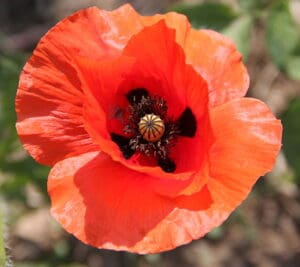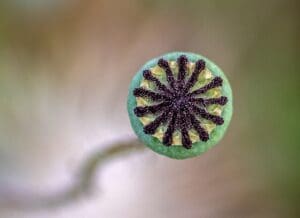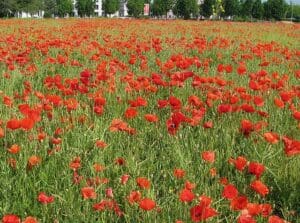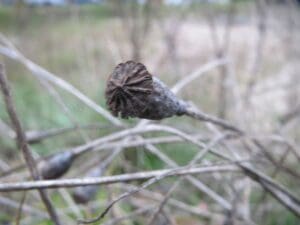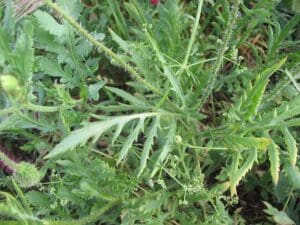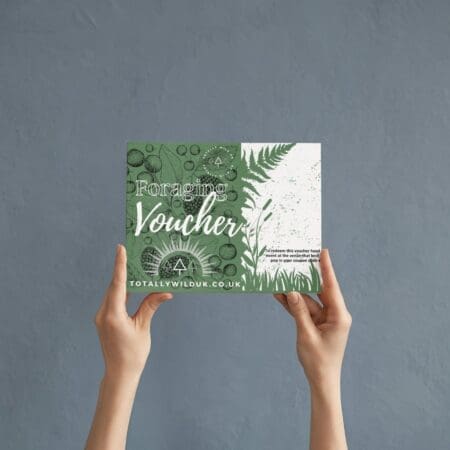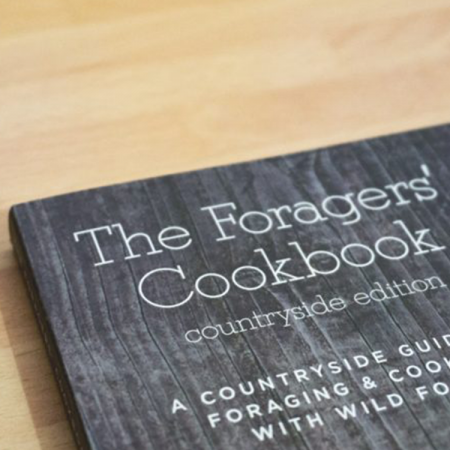Corn Poppy/ Spring / Summer / Autumn / Edible
Corn Poppy is a common member of the Poppy family, since World War I, it has been used in the Commonwealth as a symbol of remembrance for fallen soldiers because it commonly grew in fields disturbed by war.
Common Names
Corn poppy, Common poppy, Corn rose, Field poppy, Flanders poppy, red poppy
Botanical Name
Papaver Rhoeas
Scientific Classification
Kingdom – Plantae
Order – Ranunculales
Family – Papaveraceae
Physical Characteristics for Corn Poppy
Leaves
The leaves are deeply lobed, lance-shaped, and covered in fine hairs. Greyish-green in colour, soft to the touch but somewhat bristly. They grow alternately along the stem. The basal rosette leaves are more prominent in young plants.
Flowers
Corn Poppy has large, delicate petals, typically bright red with a black spot near the base.The petals are thin and paper-like, often crumpled when the flower first opens. Each flower has four petals, measuring 5–10 cm across.
The flowers are short-lived, lasting only a few days, but the plant can bloom prolifically over the summer months.
It flowers from May to August, with peak blooms in June.
Stem
Slender, erect, and covered in short, bristly hairs.They are hollow, fragile, and prone to bending in strong winds. The whole plant grows 60–80 cm tall.
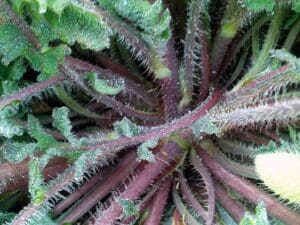
Seeds
After flowering, the plant produces a distinctive capsule-like seed pod, which is green when fresh and turns pale brown as it ripens. The capsules are oval to spherical, about 1–2 cm long, with a flattened top (known as the “stigmatic disk”).
Each pod contains hundreds of tiny black seeds.
Habitat
Poppy’s prefers open, sunny areas with light, well-drained soils. This species is commonly found in disturbed areas such as agricultural fields, roadsides, railway embankments, and wildflower meadows.
Historically they were associated with wheat, corn and barley fields due to its preference for tilled land, hence the Corn Poppy name.
Known Hazards
All parts of the plant (except seeds) contain small amounts of alkaloids, which can be toxic if consumed in large quantities. Advice states that over 250 grams of the dried flowers is possibly unsafe and may cause nausea, vomiting, seizures, changes in heartbeat, and fainting.
The seeds are perfectly safe to eat, containing none of the alkaloids associated with other parts of the plant.
The latex in the seedpods is narcotic and slightly sedative. It can be used in very small quantities, and under expert supervision, as a sleep-inducing drug.
Avoid consumption during pregnancy or breastfeeding due to potential risks.
Could be Confused with…
Could be Confused with other Poppies for example Opium Poppy (Papaver somniferum) but this has larger flowers, sometimes pink or white, much thicker stems and larger, more globular seed capsules.
Welsh Poppy (Meconopsis cambrica) but these have yellow or orange flowers.
Edible Uses
The young leaves collected early in the season when the plant is still tender can be eaten raw in salads or cooked like spinach.
Boiling removes some bitterness and mild toxicity.
The seeds, have a lovely nutty flavour,they are non-toxic and widely used as a spice or topping in breads, cakes, and pastries.
Oil extracted from seeds is used in cooking and for medicinal purposes.
The flower petals can be used to make syrups or jellies or infused to make natural red or pink food coloring
Notes on Herbal Uses
Corn poppy flower petals contain chemicals that can cause sleepiness. They can also have antioxidant effects. The petals also contain minerals, including potassium, zinc, copper, and iron. People use corn poppy for cough, insomnia, pain, withdrawal from heroin, morphine, and other opioid drugs, and other purposes, but there is no good scientific evidence to support these uses.
Find out Foraging and Herbal Medicine Online Guide Here
Extra notes from the Foragers
Corn Poppies association with blood and new life harks back to the Egyptians and Romans who made garlands of common poppies to celebrate the gods and ensure the fertility of their crops.
Since the First World War they have been used widely as a symbol of remembrance and hope as they were the first wildflower to bloom and grow amongst the chaos and destruction of the battlefields.
In 1915 John McCrae, a Canadian doctor serving in the war, wrote the poem ‘In Flanders Fields’ all about the poppy and the war. The poem was published and the poppy became an official symbol of hope and remembrance.
“In Flanders Fields the poppies grow Between the crosses, row on row, That mark our place. While in the Sky The larks still bravely singing, fly Unheard, amid the guns below. We are the dead, Short days ago We lived, felt dawns, saw sunsets glow; Loved and were loved – but now we lie In Flanders Field.”
John McCrae, 1915
References:
https://www.webmd.com/vitamins/ai/ingredientmono-525/corn-poppy
https://www.wildlifetrusts.org/wildlife-explorer/wildflowers/common-poppy
https://www.interflora.co.uk/blog/poppy-day
https://en.wikipedia.org/wiki/Papaver_rhoeas



